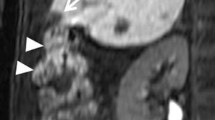Abstract
While cryoablation has been shown to be an effective method of destruction of primary and metastatic liver tumors, there is a disturbingly high incidence of recurrence at the cryoablated site and there are conflicting reports concerning long-term survival. For this reason, resection remains the preferred surgical treatment of liver tumors. However, there is a population of patients who, because of age, pre-existing liver disease, or likely systemic dissemination, present a higher risk for major resection, and for whom cryoablation may be favored. This study examined the safety and effectiveness of cryoablation in patients thought to be at higher risk for conventional hepatic resection, or in whom resection would not eradicate all known disease. Twenty-eight consecutive patients underwent cryoablation, with or without resection, of 39 hepatic tumors for primary (n = 9) or metastatic (n = 19) disease. Their postoperative course and long-term follow-up were examined for complications, survivability, and recurrence of disease. With the use of cryoablation, a major hepatic resection was avoided in 20 patients, 11 of whom were 70 years or older, 4 who likely had disseminated cancer even though the liver was the only site of detectable disease, 2 who were cirrhotic, and 2 with bilobar disease. An additional 7 patients had recurrence of disease in a previously resected liver, for whom additional resection would be hazardous. There was one operative death from an exaggerated systemic inflammatory response syndrome. Seven patients developed complications, including 2 patients with cryoablation-induced coagulopathy. Excluding 2 patients (including the postoperative death) the average hospital length of stay was 6.7 ± 2.8 days. Seven patients required some intensive care unit (ICU) care. Three patients with primary liver cancer are alive 29 to 47 months after cryoablation. Two patients with metastatic disease are alive without recurrence at 12 and 16 months, and 9 are alive with disease from 13 to 58 months after cryoablation. Fifteen patients developed liver recurrence, 5/27 (19%) at the cryoablated site. Cryoablation appears to be a safe treatment modality for primary and metastatic liver cancer. It is particularly appealing in those patients who may be at higher risk for major hepatectomy because of age, pre-existing liver disease, type of metastatic disease, previous resection, or bilobar tumors. Most disturbing is the high incidence of recurrence at the cryoablated site, which may reflect problems with ultrasound localization or proximity of tumors to major vasculature. Disease-free survival is low. From this standpoint the procedure should be considered palliative, even though all hepatic tumors can be eradicated. However, these limitations should not deter the use of cryoablation in selected patients. There is the potential for long-term survival, just as there is with resection.
Similar content being viewed by others
Author information
Authors and Affiliations
Additional information
Received: February 23, 2000 / Accepted: August 8, 2000
About this article
Cite this article
Helling, T. Realistic expectations for cryoablation of liver tumors. J Hep Bil Pancr Surg 7, 510–515 (2000). https://doi.org/10.1007/s005340070023
Issue Date:
DOI: https://doi.org/10.1007/s005340070023




